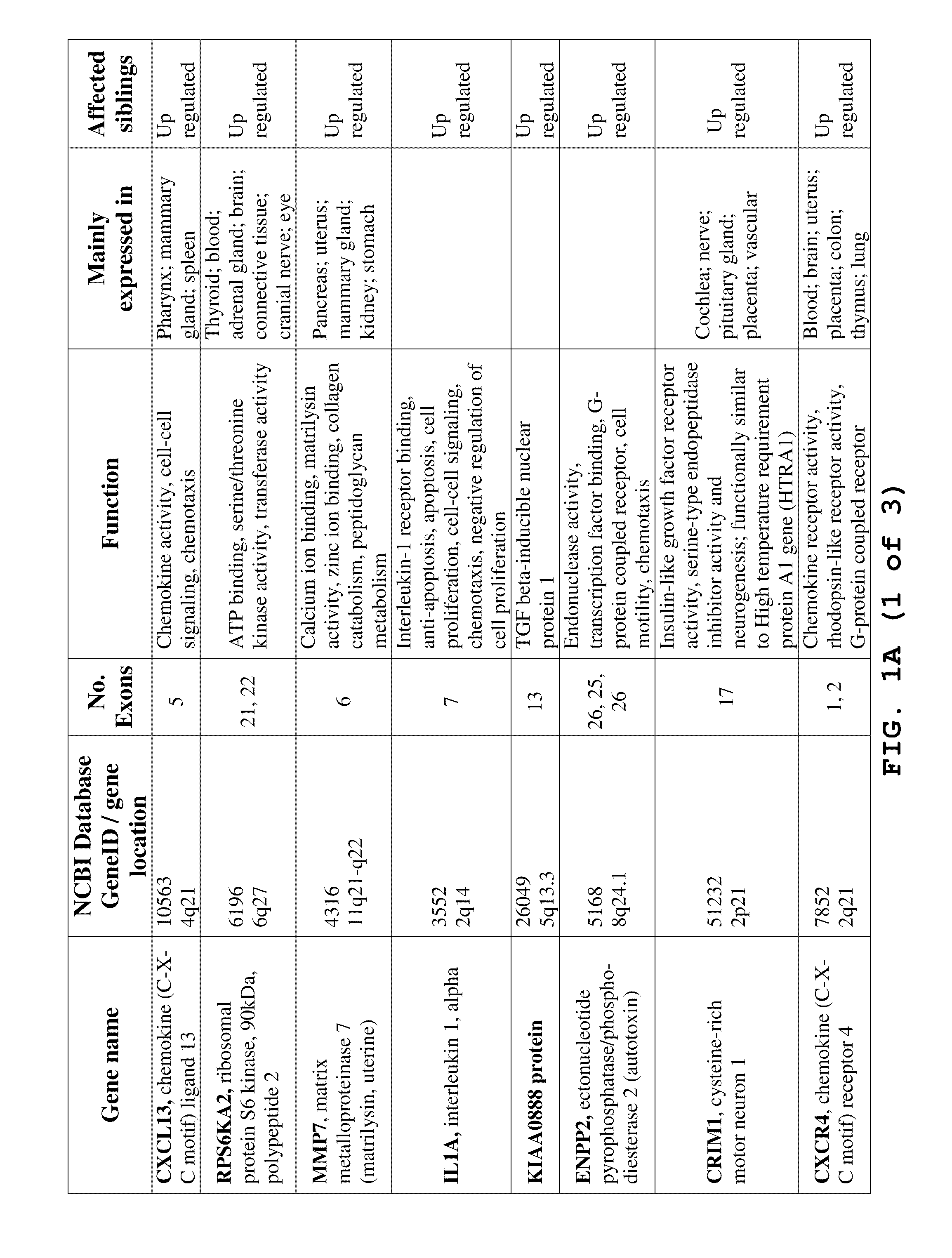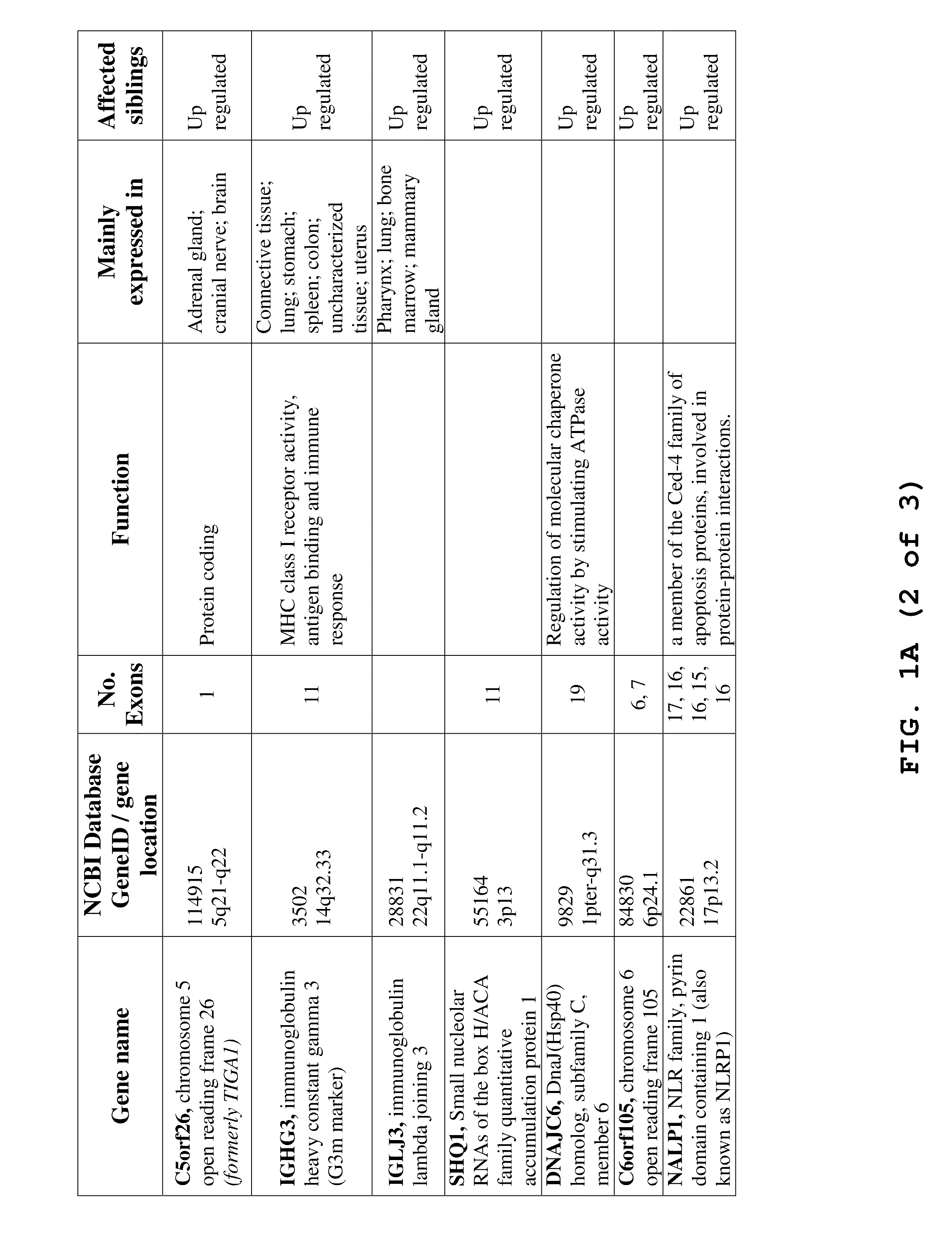Methods and Compositions for the Diagnosis and Treatment of Angiogenic Disorders
a technology for angiogenic disorders and compositions, applied in biochemistry apparatuses and processes, instruments, material analysis, etc., can solve problems such as partial or even complete vision loss, severe health problems without diagnosis and treatment, and gradual loss of vision
- Summary
- Abstract
- Description
- Claims
- Application Information
AI Technical Summary
Benefits of technology
Problems solved by technology
Method used
Image
Examples
example 1
Genome-wide Scan Using Highly Heterozygous Microsatellite Markers
[0345]In this experiment, specific genome loci having a correlation to the presence of an angiogenic disorder, namely age-related macular degeneration (AMD), are identified by comparing extremely discordant sibpairs. To analyze the extremely discordant pairs, loci were searched where, on average, the discordant pairs shared fewer than one allele at a convincing level of statistical significance.
[0346]Regions of the genome reported to harbor AMD susceptibility genes for both early or advanced forms of AMD were targeted. (DeAngelis et al. (2008) “Genetics of Age-Related Macular Degeneration” in Albert D M, Miller J W. Principles and practice of ophthalmology. Philadelphia, Pa.: Saunders, In Press.) These regions included 1q23-q41; 2p12-p25; 3p13-p25; 3q26-q12; 4q32-q13; 5p13-p14; 5q34-q12; 6q24-6q15; 9p13-9p24; 9q33-9q31; 10q26-10q23; 12q24-q23; 14q32-q13; 15q26-15q11; 16p12-p13; 17q25-17q25; 19q13; and 22q13-12. (Klein ...
example 2
Identification of Genes Related to Ocular Angiogenic Disorders
[0351]For this study, total RNA isolates from transformed lymphocyte cell lines derived from eighteen individuals (nine extremely discordant sibpairs, i.e., nine subjects affected with an angiogenic disorder, namely AMD, and nine matched sibling controls without the disorder) were quantitatively prepared using RNAEASY kits (Qiagen, Valencia, Calif.). RNA quality was determined by analysis using agarose gel or an Agilent 2100 bioanalyzer instrument (Santa Clara, Calif.). RNA was amplified, labeled, and hybridized to human Affymetrix U133A 2.0 PLUS microarrays (Santa Clara, Calif.) containing analytical elements corresponding to approximately 30,000+ genes. The nine discordant sibpairs were analyzed with gene expression microarrays.
[0352]Principal component analysis (PCA) showed substantial differences between these nine affected and unaffected siblings, therefore the microarray data was analyzed under a paired two-sample d...
example 3
Use of Selective Agonists and / or Antagonists for Treating Angiogenic Disorders
[0361]It is contemplated that a variety of antagonists for one or more of CXCL13, RPS6KA2, MMP7, IL1A, KIAA0888, ENPP2, CRIM1, CXCR4, C5orf26, IGHG3, IGLJ3, SHQ1, DNAJC6, C6orf105, NALP1, or RGS13 and / or agonists for one or more of RORA, NALP2, PLA2G4A, PKP2, UCHL1, TANC1, ABCA1, VCAN, and / or FAM38B (i.e. the treatment agents described above) will be useful to slow, stop, prevent, or reverse the progression of one or more angiogenic disorders, for example, an ocular angiogenic disorder, for example, a disorder associated with choridal neovascularization, for example, age-related macular degeneration. Examples of these compounds are listed herein.
[0362]For example, it is contemplated that an active form of RORA, NALP2, PLA2G4A, PKP2, UCHL1, TANC1, ABCA1, VCAN, or FAM38B can be administered to a subject, such as a mammal, such as a human, using techniques known to those skilled in the art so as to slow down,...
PUM
| Property | Measurement | Unit |
|---|---|---|
| nucleic acid | aaaaa | aaaaa |
Abstract
Description
Claims
Application Information
 Login to View More
Login to View More - R&D
- Intellectual Property
- Life Sciences
- Materials
- Tech Scout
- Unparalleled Data Quality
- Higher Quality Content
- 60% Fewer Hallucinations
Browse by: Latest US Patents, China's latest patents, Technical Efficacy Thesaurus, Application Domain, Technology Topic, Popular Technical Reports.
© 2025 PatSnap. All rights reserved.Legal|Privacy policy|Modern Slavery Act Transparency Statement|Sitemap|About US| Contact US: help@patsnap.com



